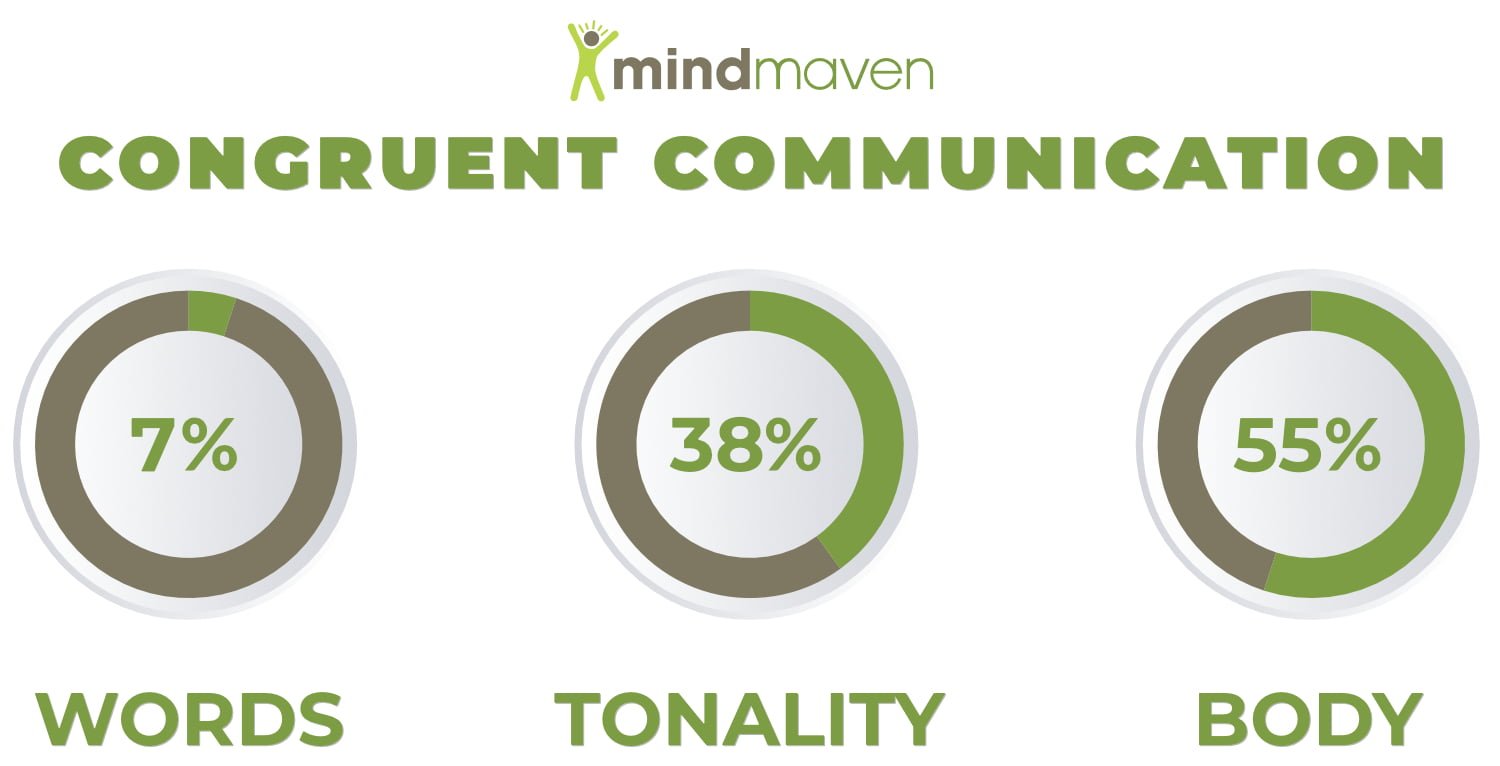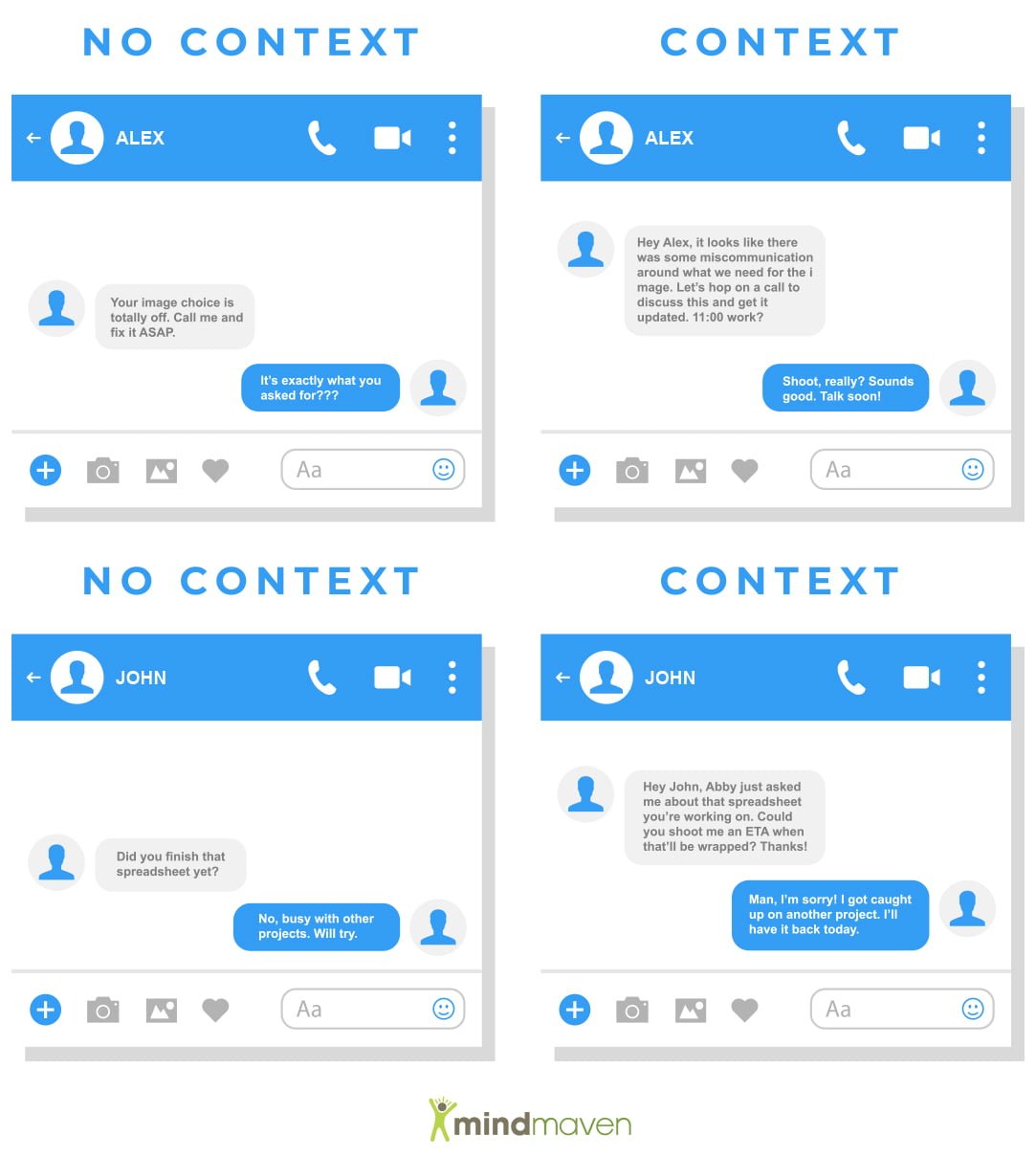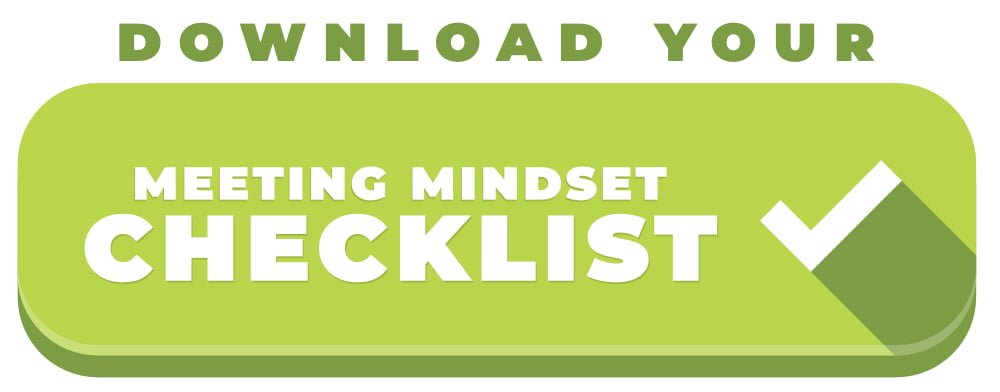
Ever had the painful experience of sending (what you thought was) a well-meaning check-in email only to have it blow up in your face when your message was completely misconstrued?
Most of us have been there and know what comes next: Time wasted attempting to eliminate miscommunications and repair the relationship. All because they misunderstood you, right?
While it’s easy to blame the other person, that’s rarely accurate. In almost all cases of communication confusion, the fault isn’t on the recipient; it’s on you.
That’s the bad news. The good news is, once you understand and accept that, it’s entirely in your power to boost your communication skills. But we’re getting ahead of ourselves—before we talk about future solutions, let’s take a closer look at what went wrong in the first place.
The Three Driving Factors of Effective Communication Skills
Back in 1967, UCLA professor Albert Mehrabian published two groundbreaking studies on communication (Decoding of Inconsistent Communications and Inference of Attitudes from Nonverbal Communication in Two Channels), introducing a then-revolutionary concept: Effective communication isn’t the result of chance. It’s a process.
In other words, communication is a skill, not a gift; and with the right understanding, anyone can learn to boost their communication skills to eliminate miscommunications effectively. At the core of this idea was the belief that effective communication skills had 3 primary components:
- Words: The actual words we use to communicate our message.
- Tonality: The tone of our voice as we deliver our words.
- Body Language: The movements of our body (especially our face) as we communicate our message.
This next part’s important: Each of the three elements above contributes to your communication skills and ability to communicate your intended message at a different level. So when you’re using all three channels (words, tonality, and body language) to communicate a message—say, in a face-to-face meeting—you’re using 100% of your communication skills.
But while the three channels all contribute toward that percentage, they are not created equally. So the question is, what’s the relative importance of each one? Before you read the answer, take a moment to come up with your own estimations; we’re curious to see how accurate your assumptions will be.
Once you’ve made your guess, check out the graph below.

That’s right: Words only contribute 7% of the message, while tonality contributes 38%, and body language weighs in at an impressive 55%.
A quick note: Those numbers aren’t an exact science to eliminate miscommunications, and there’s some debate about their accuracy when discussing communication skills. But one thing remains true: The majority of effective communication skills are non-verbal. Let’s prove it with an example.
Why Words Alone (Almost) Always Fall Short
Take the phrase, “It’s great to meet you. I’m really looking forward to working together.” Focusing on the words alone, would you say that’s a positive, negative, or neutral statement?
Most people would agree the statement seems relatively positive, right? Now, imagine that same phrase being spoken by someone making a really nasty face.
The words are the same, but the message changes dramatically. What initially seemed like a positive statement now probably feels sarcastic, condescending, or negative, right?
Alright, one more example. Imagine the statement was delivered by someone with a really happy look on their face.
What initially seemed like a positive message is now almost guaranteed to be positive, especially coupled with a genuinely excited tonality and a firm handshake.
That final example is what we call Congruent Communication: When your communication skills allow your words, tonality, and body language to be completely aligned behind a singular message. Congruent Communication allows you to much more effectively deliver your message, dramatically reduces the likelihood it’ll be misunderstood, and subconsciously builds massive trust with those you interact with.
What is Congruent Communication?
Congruent Communication is the ability to deliver a message where your words, tone, and body language are fully aligned. An essential skill for any leader wanting to create clarity, trust, and emotional resonance.
Because it’s not just what you say, but how you say it.
When you communicate solely with words (as is the case with texts and emails), you’re only communicating at about 7% efficiency. 7%!
So … What happens to the other 93%? It’s left to the other person to assume or infer your intended message.
And those assumptions? They’re largely driven by two things: Relationship and—to a greater extent—mindset.
If it’s someone you have a strong relationship with and they happen to be in a good mood, chances are they’ll interpret your message positively.
But if you don’t have an established relationship with them and they’re in a bad mood—say they just left a negative meeting—there’s a good chance they’ll interpret your message negatively (even if that’s not how it was intended).
And this isn’t only applicable to texts, emails, and other word-specific communication platforms. It’s entirely possible to communicate incongruently in a face-to-face meeting. For example: If you enter a meeting in a bad mood, that’s probably going to come across in your communication skills.
Worse still—the other person will pick up on this. Maybe not consciously, but their subconscious mind will notice a disconnect, and that realization breaches trusts and damages relationships.
At Mindmaven, we coach executives to master Congruent Communication and get the most out of every interaction—regardless of whether it’s a 6-word text for a 60-minute meeting.
Through our personalized executive coaching and pragmatic playbooks, we help leaders build stronger relationships, reduce miscommunications, and lead with more impact.
Want to learn how to master Congruent Communication? Schedule a free call with a Mindmaven coach and start leading with greater clarity and connection.
3 Actionable Tips to Build Massive Trust with Congruent Communication
The question is … How?
It starts by understanding one simple truth about communication skills: two-thirds of effective, congruent communication is largely unconscious.
While you likely have consistent, conscious control over the words you speak, your tonality and body language are primarily driven by the subconscious mind; or, put another way, by your mindset.
Here’s why that’s important: Say you leave an unproductive meeting in a bad mood. If you don’t take steps to change your attitude before entering your next meeting, it doesn’t matter what words you say: Your tonality and body language will likely deliver a negative experience to the other person.
And sure: You may be able to “fake it” for a while. But that rarely lasts. As soon as you stop paying conscious attention to your tonality and mindset—which happens naturally over the course of a meeting—they’ll become reflections of your current (negative) mindset.
So, with that said, let’s talk about 3 ways you can take ownership of your mindset and boost your communication skills to deliver better experiences and build more meaningful relationships.
#1: Match the Message to the Medium
Let’s jump back to that email example one more time. Remember, it backfired on you because you left 93% of your intended message up to the recipient to assume. The obvious solution here is to simply eliminate assumptions and, therefore, eliminate miscommunications, right?
How? By switching up your communication.
Too often, our default communication platforms are word-exclusive: texts, emails, Slack, WhatsApp, etc. And don’t get me wrong: There’s nothing wrong with these platforms, but it’s important to understand their purpose.
Word-exclusive platforms are extremely limited in their ability to communicate nuanced messages. Because of this, we highly recommend limiting their use to low-urgency, low-importance messages. For example:
- Check-ins: “Hey, it’s been a while! I’d love to grab coffee sometime.”
- Positive Alacrity: “I just wanted to let you know how much I appreciate all the hard work you’ve put into [XYZ].”
- Status updates: “Just wanted to let you know I wrapped up [XYZ]!”
That said, even those messages could likely be communicated even more effectively with tonality and body language, so keep that in mind. However, whenever possible, avoid text-exclusive platforms for situations like …
- Providing feedback (especially criticism),
- Asking for an introduction, sale, or referral, or
- Breaking bad news.
These more delicate situations—which have a higher likelihood of being misinterpreted—generally benefit from a platform that incorporates more of your communication skills, such as a phone call or face-to-face meeting.
At the end of the day, it comes down to this: Use your judgment, and prioritize the health of your relationships over the convenience of quick communication. After all, if it winds up misinterpreted, you’ll likely spend more time clearing the air than if you’d simply used a more effective channel to begin with.
#2: Context Is King
All of that said, we’ll be the first to admit that you’ll occasionally come across situations where your communication skills need to rely on word-exclusive platforms to communicate something quickly and easily. So … What do you do then?
Simply spend an extra couple of seconds “over-explaining” the situation to fill in missing context and reduce assumptions to eliminate miscommunications. Let’s give you a couple of examples.

By taking a few moments to explain the context, you can save yourself a number of potential headaches, damaged relationships, and time wasted cleaning up misunderstandings.
#3: Mind Over Matter
We mentioned above that it’s entirely possible to communicate incongruently, even if you’re meeting someone face-to-face. This happens when the words you’re saying don’t match the signals your body language or tonality may be sending. For example:
- “It’s great to meet you,” with a weak handshake and monotone voice,
- “I’ll look forward to our next meeting,” with no genuine excitement in your voice, or
- “I’ll get on this right away,” with no real urgency in your posture.
Like it or not, people pick up on these misalignments—even if only subconsciously—and these perceptions can poison your relationships. So how do we avoid this?
Simple: Remember, the majority of non-verbal communication is influenced by mindset. By simply taking 2-3 minutes before you walk into a meeting to get yourself in the right frame of mind, you can dramatically improve your communication skills and ability to deliver a great experience.
So what is the right frame of mind? It likely looks different for each interaction, but here are a few mindsets you might consider tapping into to boost your communication skills:
- Excitement for the results this meeting will create,
- Gratitude for the opportunity to meet with this person, or
- Eagerness to provide genuine value to the person you’re meeting with.
As for how to get into those mindsets, there are a number of effective strategies. For example, box breathing, short meditations, or writing out your Agenda-in-Mind for the upcoming meeting. At the end of the day, boosting your communication skills is about finding what works for you.
To help you get started, we’ve compiled our most effective recommendations into a simple, actionable resource.
Learn more about how to practice congruent communication by reading our free Meeting Mindset Checklist:
Reaping the Rewards of Congruent Communication
Alright, before we wrap this up, we want to tie it all together. Is Congruent Communication really all that important to eliminate miscommunications and boost your communication skills? We say yes. Why? Let us explain.
At the end of the day, the majority of the breakthrough opportunities we need to take our businesses to the next level come from our relationships. But the likelihood of generating those opportunities is driven by one thing: The quality of our relationships.
So, what determines that quality? One factor, above all else: Trust. And what’s the most effective way to build trust? You guessed it: displaying your communication skills through Congruent communication. Finally, how can you ensure you’re communicating congruently? With intention and mindset.
All of that to say: We hope you can see that communication skills, and more specifically the ability to communicate congruently, isn’t just a “nice to have” when it comes to your business and your relationships; it’s a “must-have.” There’s no way around it.
Our Challenge to You
We don’t want this to be another “good idea” you file away for later use. Here at Mindmaven, we pride ourselves on being pragmatic and actionable, so we’d like to leave you with a challenge:
Download our Meeting Mindset Checklist, and run it before each meeting for the next three days. Pay conscious attention to the impact it makes on others, not just on the productivity of your meetings but on the relationship value you’re able to contribute.
We think three days will be all it takes before you’re hooked, and there’s no going back.


